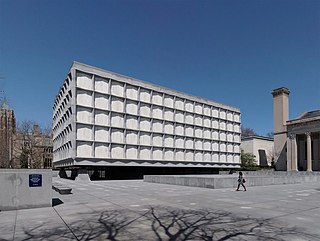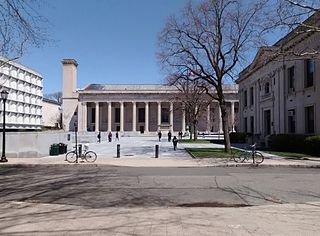
Yale University is a private Ivy League research university in New Haven, Connecticut. Founded in 1701, Yale is the third-oldest institution of higher education in the United States and one of the nine colonial colleges chartered before the American Revolution.

The Beinecke Rare Book & Manuscript Library is the rare book library and literary archive of the Yale University Library in New Haven, Connecticut. It is one of the largest buildings in the world dedicated to rare books and manuscripts and is one of the largest collections of such texts. Established by a gift of the Beinecke family and given its own financial endowment, the library is financially independent from the university and is co-governed by the University Library and Yale Corporation.

Daniel Coit Gilman was an American educator and academic. Gilman was instrumental in founding the Sheffield Scientific School at Yale College, and subsequently served as the second president of the University of California, Berkeley, as the first president of Johns Hopkins University, and as founding president of the Carnegie Institution.

The Yale School of Medicine is the graduate medical school at Yale University, a private research university in New Haven, Connecticut. It was founded in 1810 as the Medical Institution of Yale College and formally opened in 1813.
Howard Roberts Lamar was an American historian of the American West. In addition to being Sterling Professor of History Emeritus at Yale University since 1994, he served as President of Yale University from 1992 to 1993.

Sterling Memorial Library (SML) is the main library building of the Yale University Library system in New Haven, Connecticut, United States. Opened in 1931, the library was designed by James Gamble Rogers as the centerpiece of Yale's Gothic Revival campus. The library's tower has sixteen levels of bookstacks containing over 4 million volumes. Several special collections—including the university's Manuscripts & Archives—are also housed in the building. It connects via tunnel to the underground Bass Library, which holds an additional 150,000 volumes.

Hewitt University Quadrangle, commonly known as Beinecke Plaza, is a plaza at the center of the Yale University campus in New Haven, Connecticut. It is the home of the university's administration, main auditorium, and dining facilities. The quadrangle was created with the construction of the university's Bicentennial Buildings and Woodbridge Hall in 1901. Until 1917, it was known as University Court. The completion of the Beinecke Library created subterranean library facilities beneath the courtyard, establishing the present appearance of the paved plaza and sunken courtyard.

The Elizabethan Club is a social club at Yale University named for Queen Elizabeth I and her era. Its profile and members tend toward a literary disposition, and conversation is one of the Club's chief purposes.

The Yale Graduate School of Arts and Sciences is the graduate school of Yale University. Founded in 1847, it is the oldest graduate school in North America, and was the first North American graduate school to confer a Doctor of Philosophy (Ph.D.) degree.

Columbia University Libraries is the library system of Columbia University and one of the largest academic library systems in North America. With 15.0 million volumes and over 160,000 journals and serials, as well as extensive electronic resources, manuscripts, rare books, microforms, maps, and graphic and audio-visual materials, it is the fifth-largest academic library in the United States and the largest academic library in the State of New York. Additionally, the closely affiliated Jewish Theological Seminary Library holds over 400,000 volumes, which combined makes the Columbia University Libraries the third-largest academic library, and the second-largest private library in the United States.

The Lillian Goldman Law Library in Memory of Sol Goldman, commonly known as the Yale Law Library, is the law library of Yale Law School. It is located in the Sterling Law Building and has almost 800,000 volumes of print materials and about 10,000 active serial titles, in which there are 200,000 volumes of foreign and international law materials. The library was named after a US$20 million donation made by Lillian Goldman, widow of real estate magnate Sol Goldman.

The Harvey Cushing and John Hay Whitney Medical Library is the central library of the Yale School of Medicine, Yale School of Nursing, and Yale-New Haven Hospital in New Haven, Connecticut.

The Rare Book & Manuscript Library is principal repository for special collections of Columbia University. Located in New York City on the university's Morningside Heights campus, its collections span more than 4,000 years, from early Mesopotamia to the present day, and span a variety of formats: cuneiform tablets, papyri, and ostraca, medieval and Renaissance manuscripts, early printed books, works of art, posters, photographs, realia, sound and moving image recordings, and born-digital archives. Areas of collecting emphasis include American history, Russian and East European émigré history and culture, Columbia University history, comics and cartoons, philanthropy and social reform, the history of mathematics, human rights advocacy, Hebraica and Judaica, Latino arts and activism, literature and publishing, medieval and Renaissance manuscripts, oral history, performing arts, and printing history and the book arts.
Laurence C. Witten II, was an American rare book dealer and collector of antiquities.
Percy Marks was an American writer and college English instructor best known for his best selling 1924 novel, The Plastic Age.

Science Hill is an area of the Yale University campus primarily devoted to physical and biological sciences. It is located in the Prospect Hill neighborhood of New Haven, Connecticut.

The Main Library is a historic library on the campus of the University of Illinois Urbana-Champaign in Urbana, Illinois. Built in 1924, the library was the third built for the school; it replaced Altgeld Hall, which had become too small for the university's collections. Architect Charles A. Platt designed the Georgian Revival building, one of several on the campus which he designed in the style. The building houses several area libraries, as well as the University Archives and the Rare Book & Manuscript Library. The Main Library is the symbolic face of the University Library, which has the second largest university library collection in the United States.
Chauncey Brewster Tinker was a scholar of English Literature and Sterling Professor at Yale University.
James Tinkham Babb was an American librarian and book collector affiliated with Yale University. He was born in Lewiston, Idaho. He attended Phillips Exeter Academy and Yale College. He was a member of the Acorn Club and served as University Librarian from 1945 to 1965. He served as president of the Connecticut Library Association and councilor of the Bibliographical Society of America; he was elected to the American Antiquarian Society in 1946.




















